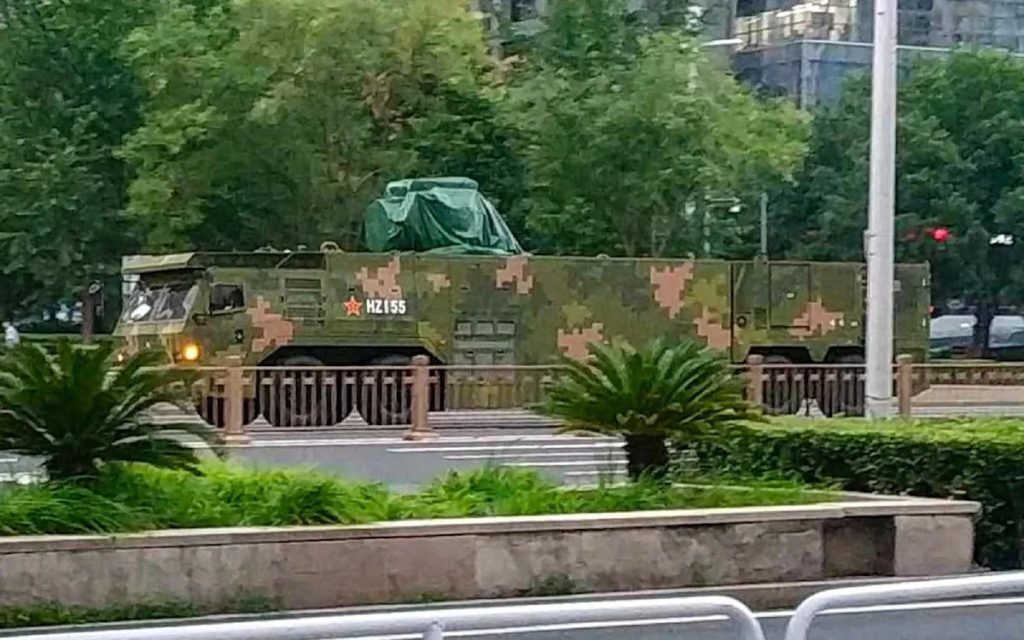The Emergence of Laser Warfare: A Close Look at China’s Advanced Military Parade
It did not appear particularly impressive during the rehearsals: an unidentified weapons system hidden beneath a green tarpaulin, mounted precariously on an eight-wheeler truck. However, the veil will be lifted on Wednesday during the People’s Liberation Army (PLA) parade in Beijing, revealing what is touted as “the most powerful laser air defense system in the world.” This claim comes from the stylized rhetoric of the Chinese military, signaling a potent shift in modern warfare.
A Show of Power
This grand display is not merely about unveiling new technology; it symbolizes China’s ambitions to project itself as an integrated military force capable of rivaling, and perhaps surpassing, that of the United States. The laser weapon system is just one of many high-tech exhibits likely to command attention during the parade, which commemorates the 80th anniversary of Japan’s surrender in World War II.
Global leaders, including Vladimir Putin and Kim Jong-Un, are expected to be in attendance alongside Chinese President Xi Jinping, observing the fruits of decades of intense military investment. The scale and precision of this parade are set to outshine recent displays from Moscow and Washington, highlighting China’s significant military expenditure and technological advancements.
Analyzing the Threat
U.S. defense analysts are particularly keen on the revelations from this parade. Their focus is not just on the flashy display of machinery but rather on assessing potential threats to American forces, especially concerning possible contingencies involving Taiwan. The stakes are high, with U.S. intelligence suggesting an increased probability of conflict around 2027.
Rehearsal photographs have hinted at further developments, including the addition of four new anti-ship missiles classified under the “YJ” or “eagle attack” category. Each of these missiles poses a considerable threat to any American or British naval intervention, demonstrating China’s growing military capabilities in the maritime domain.
Evaluating the Credibility of Chinese Technology
The question on the minds of analysts revolves around the authenticity and efficacy of the showcased weaponry. Rob Peters, a senior research fellow at the Heritage Foundation, expressed skepticism, urging a cautious approach regarding the perceived advancements of Chinese military technology. The PLA has not been tested in combat since its last engagement in 1979, which raises questions about the real-world effectiveness of its advanced systems.
Recent Military Engagements
Despite the PLA’s limited combat history, recent events have demonstrated the operational capabilities of Chinese technology. In May, Pakistan utilized Chinese-made J-10 fighters and PL-15 missiles to successfully engage and shoot down an Indian Rafale fighter jet, marking a significant milestone for PLA technology in real-world combat conditions. Additionally, Chinese drone operations have become increasingly prominent in the ongoing conflict in Ukraine, showcasing their versatility and effectiveness in modern warfare scenarios.
The Evolution of Military Parades
China’s military parades have evolved over the years, marking transitional phases in its defense procurement strategies. The parade themes have varied, with 2015 emphasizing strategic missiles aimed at the U.S. mainland and 2019 showcasing drones, including the GJ-11 attack drone. This year, there are speculations about the debut of the new GJ-11 Sharp Sword, designed to operate as a “loyal wingman” alongside piloted aircraft.
The Growing Significance of Laser Weaponry
The increasing focus on laser technology reflects its rising importance among militaries worldwide. With advancements in powered energy and increased reliability, laser systems offer innovative solutions against various aerial threats. High-energy laser weapons provide an "infinite magazine," enabling them to engage targets for a fraction of the cost compared to traditional missile systems.
The Israeli Defense Forces recently became the first to showcase a successful combat intercept using laser systems, a move indicative of a burgeoning trend toward directed energy weapons in current military arsenals. Trials conducted by entities such as the Royal Navy focus on operationalizing these high-energy systems for battlefield application, revealing ongoing advancements in laser technologies.
Navigating Challenges Ahead
However, there remain significant challenges to the widespread adoption of laser technologies. Sceptics often remark on the persistent “laser gap,” a phrase originally coined regarding U.S.-Soviet military capabilities in the 1980s. The practical constraints concerning power supply, environmental conditions, and the operational complexities of deploying such systems in active combat remain formidable hurdles to overcome.
U.S. Military Developments
The U.S. military has faced setbacks in its pursuit of laser warfare. Plans for implementing high-energy lasers on various platforms are under reconsideration due to insufficient test results. For instance, recent reports indicate a 60kW laser system on the USS Preble is functioning below its intended capacity, reflecting the technological hurdles that must be addressed before laser systems can be reliably deployed in combat.
Amid these challenges, the underlying trajectory toward integrating laser technologies into military operations is clear. Analysts point toward a potential tipping point, where improvements in supporting technologies and power sources could facilitate the successful deployment of these systems.
China’s Strategic Laser Systems
The laser system slated for display in Beijing is believed to be a 10kW OW5-A10 capable of intercepting drone swarms—an increasingly relevant threat in modern warfare. It stands among a range of innovative Chinese military technologies, including the “Silent Hunter,” which has been implicated in recent conflicts.
This ongoing arms race, particularly in laser weaponry, underscores the shifting paradigms in military strategy and procurement globally. The rhetoric around Chinese capabilities may sound formidable, yet as military analysts attest, a multitude of nations across the battlefield, including China, are striving to attain equitable technological advancement.
The conversation around next-generation warfare is shifting, and while the advent of directed energy weapons promises a fascinating evolution in combat dynamics, we remain far from scenarios of classic science fiction, where lasers devastate entire fleets with ease. Nevertheless, the entry of next-level technologies like these represents a significant turning point, promising to redefine the landscape of modern warfare.

